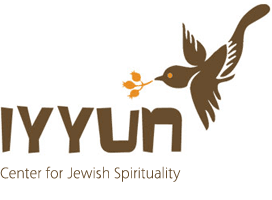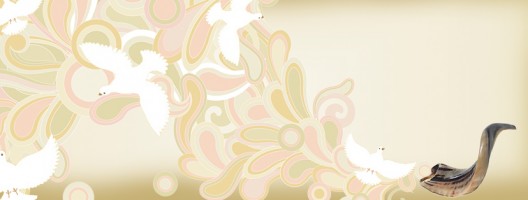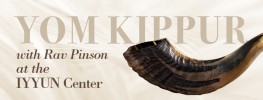Amongst all other holidays, Yom Kippur is acknowledged as the most holy and sublime. On a simple level, it appears that Yom Kippur is a day dedicated to repentance, but is this really the case? Think of it, first is Rosh Hashanah, the “day of judgment” and then Yom Kippur a day of repentance. Does the following sequence make any sense:
Imagine someone is about to be judged, wanting to ease the judgment wouldn’t they first attempt to come in front of the judge or jurors, confess their wrong doing, and then be asked to be judge accordingly instead of waiting for judgment and then afterwards confess. So why would a day of repentance follow a day dedicated to judgment?
Wrestling with Dirt
How does the holiest day tangle with a day to recount all one’s wrong doing? Can it be that on this holiest of holy times there’s nothing better to talk about than all the garbage one has collected over the preceding year?
Understandably, the negative is brought up to memory for the purpose of purging oneself, as we cannot forget and let go that which we do not remember and own, yet it is equally true “that one who wrestles with a muddied person is bound to become muddied himself.”
Although there is a place for penetrating involved awareness of your negative behavior, perhaps Yom Kippur would not be the time. And indeed it is not. Yom Kippur is not about recounting, recalling, bringing to memory all your negative baggage, for that there is the entire month of Elul.
Elul is a time when we honestly do a soul searching, a self examination and aspire to right the wrongs. It is a time where we sincerely analyze our behavior, repair, if there is any damage, and firmly resolve to better our future. After the month of Elul comes to a close we are then ready Rosh Hashanah, the “day of judgment.”
What then is Yom Kippur?
Separated Time/Space/Consciousness
This universe is comprised of time, space, and consciousness. There are three properties to creation; olam -space, shana – time and nefesh -soul. Whatever and wherever we are, we are always in some location, at a certain time, and in a particular state of mind. These three are so intensely linked that one cannot and does not exist without the others; time and space only become ‘absolutes’ when a consciousness, an observer observes them as such.
Time space and consciousness expand from a focal point, meaning the flow of time, the origin of space, and the extension of consciousness evolves from a point of reference. Time/Space/Normative Consciousness function in a universe of polarity, separateness, diversity and fragmentation. In linear time, there is a past which imprints upon a present which in turn effect a future, the same is with space. Space has defined dimensions, a width, height, and depth. The observer, the consciousness who perceives time and space in this fragmented manner is precisely the creator of all this diversity as he is merely projectinghis own inner polarity, duality and inner rift onto the life that surrounds him.
Unified Time/Space/ Consciousness
Yet, for all the multiplicity and division there is central point, that is one, unified and whole, from where all separation and diversity emanate. Cleary, the center of all reality and existence is the Creator, but as a manifestation and representation of this oneness, there is an expression of oneness in time, space and consciousness, a point from which all duality flows. There is a time/space/soul reality in which the infinite oneness begins to stream outward into finite reality and where the finite separate, and infinite oneness are unified and inseparable.
Yom Kippur reflects oneness and unification on all three levels, in time, space and consciousness.
With respect to time, Yom Kippur is referred to as achas ba’shana – the Oneness of the Year. Year-in Hebrew shana, is a word related to the word shinui, meaning change, as the flow of the year cycle bespeaks of diversity and the changing of seasons. And in the midst of this multiplicity, Yom Kippur stands as achas ba’shana, the focal point of time expressing the ultimate oneness of time from where all multiple time reality emerges.
Likewise, Yom Kippur is associated with the oneness and unification of space. When the bies ha’mikdash – the Temple in Jerusalem still stood, it was only on Yom Kippur that the High Priest was permitted to enter the sacred space of kadosh kadoshim – Holy of Holies. There, the Ark of the Covenant stood over the even hashesiya - the foundation stone, the mystical mysterious rock from which the entire physical space extended, as the Talmud relates.
The Ark of the Covenant was as physical as anything else, a manifestation of this material existence with physical properties, and yet, when placed in the Holy of Holies, it did not consume any space. If one were to measure from the outside wall of the Ark in any direction, the sum total of the empty areas would be the same as the sum total of the entire space of the Holy of Holies.
Paradoxically, the Ark contained a definite measurement, and yet did not take up any space, a total melding, unification and reintegration of dimension into the dimensionless, of space into spacelessness, though all the while the Ark itself retained its dimension and ‘spaceness.’
Revealing Our Essential Self
And finally, and most importantly, Yom Kippur reveals the oneness of our deepest self.
Sadly, hopefully infrequently, it may occur that the way we act and behave-our outer reflection is not consistent with our inner truth. We may stray from our inner path and in the process eclipse our inner light, yet, no matter how far or alienated we may have become, our inner light can never be extinguished.
At our core we are pure and transcendent, and any negativity we engage in is not who we are, rather what we may have done. The essence of who we are remains unscathed. The consequences of our negative actions can penetrate but the surface, and can attach themselves to us merely as appendages. True they may weigh us down, burden us, cloud our vision, but they cannot affect nor influence the deepest infinite part of ourselves-the soul which is always one, pure and unified.
Yom Kippur give us the power to top into our deepest, infinite, non-dualistic selves. It is a day when we rise above our ego and fully tap into the deepest recesses of our free soul.
Comic Empowerment for teshuvah
Meta-historically, Yom Kippur was chosen as a day of teshuvah because it was the original day of forgiveness at the time of the birth of the Jewish nation.
A mere six weeks following the monumental Divine encounter at Sinai, when the absolute Oneness was clear and transparent, the Ancient Hebrews danced around the Golden Calf and proclaimed, “this is the god that took us out of Egypt.” The desire to idolize and worship an image was so powerful, the human binary need to conceptualize and contextualize was so overwhelming that they were not able to assimilate Sinai properly.
Some eighty days later, after much prayer and beseeching Moshe- Moses secured forgiveness, a means to re-access the highest levels even after one has fallen. That day was the tenth day of the seventh month of Tishrei, the day to be designated by the Torah as Yom Kippur.
On Yom Kippur, the Talmud says “the essence of the day brings atonement.” The day of Yom Kippur calls forth sublime measures of transcendence which overshadows and eliminates all externalities and thus all negativities. Whether we fully consciously participate or not makes little difference, so long as we minimally accept the healing power of the day, and certainly don’t interfere.
Inspiration & Perspiration
Yet, if we wish to live Yom Kippurdik — in the consciousness of Yom Kippur each day of the year, to integrate the ‘high’ of Yom Kippur in the ‘lows’ of daily mundane life we need to aspire to fuse the inspiration from above with the perspiration from below.
Indeed Yom Kippur includes both these aspects, on the one hand it is a time when “the essence of the day brings atonement”, yet, Yom Kippur follows the intense personal development of Elul. Yom Kippur comes about on the calendar only after we have attained the full potential of our own activities during Elul. Elul culminates with Yom Kippur.
As a reflection of this joining of heaven and earth, inspiration and participation, “arousal from above” and “arousal from below” these two complimentary ideas are alluded to in the two verses in the Torah which mention Yom Kippur as a day that is a Shabbas Shabbason-a Shabbas of total rest;
- “Shabbas Shabbason he lachem” (Leviticus 16:31), which means “A total day of rest it (literally she) will be to you”
- “Shabbas Shabbason hu lachem” (Leviticus 23:32), which means “A total day of rest it (literally he) will be to you”
So there is the feminine and the masculine form of Yom Kippur. On a cosmic level the feminine represents the receiver, whereas the masculine the giver. The feminine reflects a passive mood of receiving, whereas the masculine is the proactive. On Yom Kippur there is a total melding of the two into one, beyond duality, beyond separation of inspiration and perspiration.
A Day of Transcendence, A Time of Immanence
On Yom Kippur we have the ability to attain transcendence, and become angel-like. Yom Kippur is a day of rest from normative bodily necessities. The restrictions of the day are not primarily intended to cause a suffering to the body-if inflicting pain was the intention there would be many much more effective ways of doing so-rather, the focus here is to cease operating in the normative physical sphere and ascend to function angelically. It is a day dedicated to the achievement of transcendence of the physical, as well as a transcendence of all negativity and indiscretion.
While every other day of the year we may struggle internally, sense a deep dichotomy between the vying forces within us, battle our own inner satan, on Yom Kippur, we experience a transcendence of all separations, and thus all negativity and deprecation.
The Hebrew word for the Satan — ha’satan, which describes dividing, confining ego-consciousness, has the numerical value of 364. he-5, shin-300, tes-9, nun-50= 364. From this the sages of the Talmud understood that on 364 of 365 days of the year, we may struggle with our ego-oriented self, but on one day-on Yom Kippur-we are given the power to completely transcend all limitations, restrictions and division and be angelic.
On Yom Kippur total transcendence takes place. This is a day when we refrain-we are shoves “rest”, as the root word of Shabbas, from eating, drinking and satisfying other bodily needs. There is a complete materialistic transcendence-a rest from all things physical as we become angelic.
We rest from all physical activities, such as eating, drinking, marital relationships, even from walking/movement, represented by the prohibition against wearing leather shoes. Many have the custom to stand as much as possible during the prayers, also to mimic angelic activity. As angles are peaceful towards each other, we too, ask forgiveness from one another. During the course of the prayers, a white robe (kittel) and white prayer shawl (talis) are worn in imitation of angels who are “dressed” in pure immaculate white.
Ratzu & Shuve
And yet, the point of elevation of Yom Kippur is in the downward return-when we are able to draw down the inspiration into our day-to-day lives, within the here and now of the year that follows.
On Yom Kippur, we are asked to remind ourselves of the sons of Aharon who died on Yom Kippur “when they approached God.” The sons of Aharon died in ecstatic rapture. They transcended material form in divine ecstasy, in a state of “withdrawal without return.” By recalling their deaths, we are reminded that the most important part of the transcendent experience of Yom Kippur is drawing the inspiration down into our everyday reality. To experience a ratzu, an urge and deep desire to transcend and be angelic, together with shuve,-the root word of teshuvah, the great awareness that the purpose is in the return.
Liability into Assets
The ultimate return, teshuvah is when we can inspire a radical shift of our past, even the negative past, and transform all of our past into a positive context within the present. In the language of the Talmud, teshuvah of love transforms “willful transgression into positive virtue.”
How can this happen?
For one, it is precisely our previous negative actions that motivate our current deep yearning to return, and attain a more profound level of teshuvah. Our negative behavior of the past may act as a spring-propelling us forward to positive behavior in the present. This, from the new vantage point, is the kernel of goodness and light within the seemingly negative and darkness.
Retroactively speaking, the divine goodness within negative actions is that it can, and often does, awaken within the person a deeper want to return and alter one’s ways.
For this reason in Hebrew the word for “misdeed” is chet, spelled ches,-tes,-aleph. Technically, the word chet can be written without the final letter aleph, which is silent and thus apparently superfluous. And yet chet has an aleph-the first letter of the Hebrew alphabet and the phonetic opening of all sound, a letter which represents the First, the One and the Only.
May we consciously be aware of this day of achas ba’shana – oneness of time, and attain a sweetening of our entire selves within in the newly discovered self.
May we merit to top into the awesomeness of Yom Kippur, and reveal our deepest self. May the effects of our personal inner transformation be felt throughout the entire world. May we allow for the “essence of the day” to bring us to a real teshuvah, and through our own teshuvah inspire a teshuvah for the entire world, as the world becomes healed and repaired of its fragmentations, splinteredness, and apparent senselessness.










